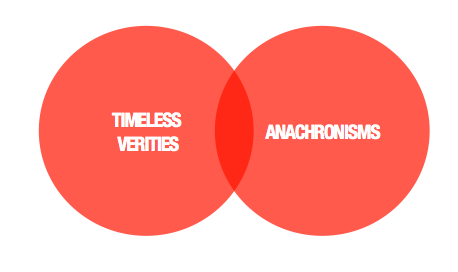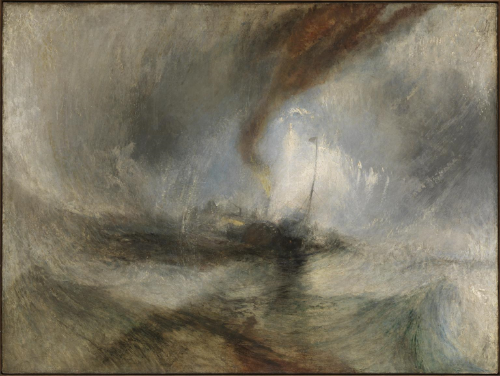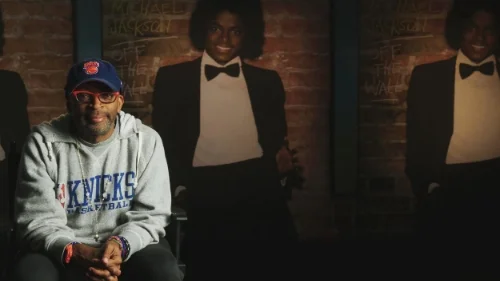I Saw the Moon in the Morning: Beware the Effects of Institutional Ageing
Image courtesy: http://motodometer.blogspot.co.uk/
‘The moon is up, and yet it is not night,
The sun as yet divides the day with her.’
Lord Byron, Childe Harold’s Pilgrimage
Once as a child I saw the moon in the morning. It was early. I was on my way to school and there in the silence and soft light, low above the suburban rooftops, hovered a beautiful full moon. I couldn’t believe my eyes. The mysterious sight troubled me all day and, when I returned home, I asked my mother about it. ‘Mum, how can the sun and moon be out at the same time?’ She put a reassuring hand on my shoulder. ’Jimmy, the world is full of wonderful things.’
When we’re young the world is indeed brimming with the strange and surprising, curious and confusing. When we’re young ‘firsts’ come at us apace: first step, first kiss, first job, first love. We are constantly challenged to rethink our understanding of the universe; to guess and hypothesize; envisage and imagine. This is possibly why many of us are most creative in our youth.
As the years pass, we learn and understand. Things make sense. The frequency of firsts dwindles to a trickle. With middle age we are reduced to surveying ludicrous bucket lists for new thrills. And we begin to experience ‘lasts’: my last night of sweaty clubbing; my last ponderous performance on the football pitch; my last egg-and-chips at the New Piccadilly Café; my last conversation with my mother. In mid-life we can lose our sense of wonder.
Inevitably organisations experience their own equivalent of this: Institutional Ageing. As businesses mature, they become more complex, sophisticated, sensible. They are more absorbed by process and management. They take on more support and technical staff. Their vision and values are anchored in a time that recedes into the distance. They become more engaged with titles and structure than teams and culture; more worried about relationships than ideas; more concerned with conserving what they have than gaining what they have not. They are more conservative.
Inevitably with time companies become corporate.
Yet creative businesses in particular must sustain an appetite for innovation and invention; an aptitude for possibility and opportunity. This is what our clients pay for. Creative businesses must retain their youthfulness.
I worked for the communications agency BBH for 24 years. When John Bartle, sage strategist and company founder, left the business in 1999, he encouraged us to ‘immature with age.’ But how do we do this?
In part it’s about employing and empowering young people; sustaining a flow of new perspectives and ideas into the heart of the corporate consciousness. However, there’s also a need to resist the gravitational pull of Institutional Ageing. Bartle warned that ‘the opposite of creativity is cynicism;’ that we must combat corrosive scepticism, caustic sarcasm. I’m sure he was right.
As I’ve grown older I’ve noticed an impulse to dismiss the new and original as familiar and derivative. With age and experience we are cursed with the memory of past disappointments, flawed precedents. We’ve seen it, done it, tried it before. We are denied the blind enthusiasms and full-blooded convictions of our adolescence.
But it must be possible to inoculate ourselves against this cynicism. Consider two creative professionals who retained their youthful spirit into old age: Diana Vreeland and Bill Cunningham.
Diana Vreeland: The Dreamer
‘There’s only one good life and that’s the life that you know you want and you make it yourself.’
The excellent 2011 documentary Diana Vreeland: The Eye Has To Travel, recounts the life and work of the legendary editor of Harper’s Bazaar and Vogue.
Born in Belle Epoque Paris, coming of age in New York in the Roaring Twenties, Vreeland brought vision, imagination and invention to her magazines.
‘I believe in dreams. I think we only live through our dreams and our imagination. That’s the only reality we really ever know.’
Vreeland cherished bikinis and Lauren Bacall, dance and David Bailey, velvet mittens and Veruschka. She valued style over fashion, artifice over nature, fantasy over reality.
‘Red is the great clarifier – bright, cleansing, revealing. It makes all colors beautiful. I can’t imagine being bored with it.’
Reclining in her scarlet-decorated living room, her ‘garden in hell,’ cheeks brushed generously with rouge, Vreeland dispensed aphorisms with carefree abandon. (‘The best thing about London is Paris.’ ‘I loathe narcissism, but I approve of vanity.’) Fascinated by difference, she was always drawn to distinct human features and looks: Barbra Streisand’s extravagant nose, Penelope Tree’s angular cheekbones, Twiggy’s skinny body shape.
‘Make an asset of your faults. If you’re tall, be taller; wear high heel shoes. If you have a long nose, hold it up and make it your trademark.’
Throughout her life Vreeland was restless, demanding, intensely romantic. She was contradictory, infuriating, passionate. She stayed forever young.
‘I will die young. I may be 70 or 80 or 90, but I will be very young.’
Bill Cunningham: The Quest for Beauty
‘Money is the cheapest thing. Liberty is the most expensive.’
Bill Cunningham, the New York fashion and street photographer, also died young, at 87 in June of this year. Cunningham was wide-eyed and enthusiastic, humble and gentle. His very particular character is captured in the splendid documentary film Bill Cunningham New York (2011).
Boston-born, Cunningham dropped out of Harvard and became a milliner. He subsequently took up street photography, gaining a role at the New York Times in 1978 after he took a rare shot of the reclusive Greta Garbo.
‘The best fashion show is definitely on the street. Always has been and always will be.’
Kitted out in his royal blue Parisian street sweepers’ jacket, Cunningham cycled round Manhattan looking for looks. Always smiling, he charmed everyday people, fashionistas and socialites to perform for the camera. And yet he lived frugally and alone, in a small artist’s apartment in the Carnegie Hall building, surrounded by filing cabinets filled with his photographs. He valued his independence, declining gifts from Clients and never consuming the free food and drink at parties.
‘I’m really only doing this for myself. I’m stealing people’s shadows, so I don’t feel as guilty when I don’t sell them.’
Cunningham seemed an intensely private individual, happy to be engaged in the profession he loved, unencumbered by commitments, relationships or material assets. Working to the end of his long life, this was a free man with a simple passion for beauty.
‘He who seeks beauty will find it.’
Eternal Youth in Business
So what are we to conclude?
For me the secret of eternal youth for business cannot be mindless carousing in inappropriate party shirts; unseemly expeditions on Harley-Davidsons. It’s more than this. It’s retaining an open mind and an eager eye, despite the disappointments of the passing years and the wearying effects of experience. Individually and collectively, we must sustain our sense of wonder.
Just occasionally I still see the moon in the morning and I still marvel at it. Mum was right. ‘The world is full of wonderful things.’ As we grow older we just have to try harder to see them.
‘May your hands always be busy,
May your feet always be swift.
May you have a strong foundation
When the winds of changes shift.
May your heart always be joyful
And may your song always be sung.
May you stay forever young.’
Bob Dylan, Forever Young
A shorter version of this piece first appeared on Guardian Media and Tech Network on 5 July 2016
No. 91



















